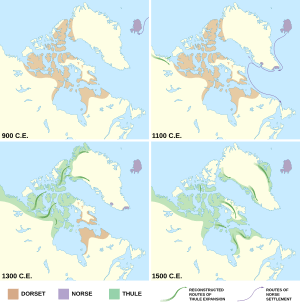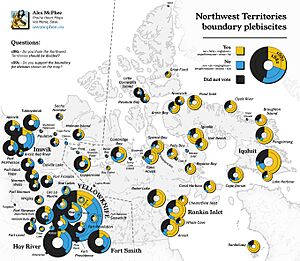History of Nunavut facts for kids
The history of Nunavut tells the story of this northern Canadian territory, from thousands of years ago to today. Long before Europeans arrived, different groups of people lived here. These included the ancient Arctic people known as the Pre-Dorset, the Dorsets, and the Thule. The Thule people are the ancestors of today's Inuit.

From the 1700s, the British claimed this land. Parts of Nunavut were managed as Rupert's Land, the North-Western Territory, or the British Arctic Territories. In 1870, Rupert's Land and the North-Western Territory were given to the Canadian government. The British Arctic Territories followed in 1880.
At first, Nunavut was part of the Northwest Territories. By 1912, this territory only included lands north of the 60th parallel and east of Yukon.
In the late 1900s, the Canadian government talked with the Inuit Tapiriit Kanatami, an Inuit organization. They signed the Nunavut Land Claims Agreement on May 25, 1993. This agreement set up a six-year period to create a new territory. Nunavut officially became a Canadian territory on April 1, 1999.
Contents
Mainland Nunavut was first settled about 4,500 years ago. The Pre-Dorset people, an ancient Arctic culture, moved here from the Bering Strait area. This region once connected Asia and America. Evidence shows the Pre-Dorset people moved often. They followed the seasons to find food and other resources.
The Dorset Culture
The Dorset culture followed the Pre-Dorset people about 2,800 years ago. The Dorset people had different stone tools, art, and building styles. Unlike the Pre-Dorset, they did not use the bow and arrow. People think the Dorset culture grew from the Pre-Dorset. However, their exact connection is still not fully clear.
Some stories from Norse explorers mention a place called Helluland. This place might have been Baffin Island in Nunavut. But whether the Dorset people met the Norse is still debated.
The Thule People

The Thule people are the ancestors of today's Inuit. They started moving into the Northwest Territories and Nunavut from Alaska in the 11th century. By 1300, Thule settlements covered most of modern Nunavut.
Scientists have different ideas about why the Thule moved. One main idea is that changes in bowhead whale populations caused by a warmer climate drew Thule hunters west. Other ideas suggest they moved due to too many people, wars, over-hunting, or iron found in Greenland.
The Thule migration happened as the Dorset culture declined. The Dorset people died out between 800 and 1500. The Thule settlers might have used some Dorset hunting tools. However, there is almost no proof that the two groups met.
Early European Explorers
The written history of Nunavut began in 1576. English explorer Martin Frobisher wrote about his trip. He was looking for the Northwest Passage, a sea route through the Arctic. Frobisher thought he found gold near what is now Frobisher Bay on Baffin Island. The "gold" turned out to be worthless. However, Frobisher made the first recorded European contact with the Inuit.
Other explorers searched for the Northwest Passage in the 17th century. These included Henry Hudson, William Baffin, and Robert Bylot.
Forced Moves During the Cold War
Cornwallis and Ellesmere Islands played a role in the Cold War in the 1950s. Canada wanted to show it controlled the High Arctic. This area was important for its location. Because of this, the government decided to make Inuit families move. They moved them from northern Quebec to Resolute and Grise Fiord.
The first group moved in 1953 from Inukjuak, Quebec, and from Pond Inlet, Nunavut. They were promised homes and animals to hunt. But the people found no buildings and very few familiar animals. They also had to live through weeks of 24-hour darkness in winter. In summer, they had 24-hour sunlight. This was very different from northern Quebec.
The Inuit were told they could return home after a year if they wanted. But this offer was taken back. The government feared it would weaken Canada's claim to the area. So, the Inuit were forced to stay. Eventually, the Inuit learned the routes of beluga whales. They learned to survive by hunting over a huge area each year.
In 1993, the Canadian government held meetings to look into this relocation program. A report called The High Arctic Relocation: A Report on the 1953–55 Relocation was released. The government paid $10 million CAD to the survivors and their families. However, they did not apologize until August 18, 2010.
Steps Towards Self-Rule
Before the 1970s, people discussed splitting the Northwest Territories. This would help the government better serve the people living there. In 1966, a public group looked into the Northwest Territories government. They suggested not dividing the territory at that time.
In 1976, the idea of dividing the Northwest Territories came up again. This was part of land claim talks between the Inuit Tapiriit Kanatami and the Canadian government. On April 14, 1982, people across the Northwest Territories voted on the division. Most residents voted yes. The federal government agreed seven months later, with some conditions.
The land claims agreement was finalized in September 1992. Nearly 85% of voters in Nunavut approved it in a special vote. On May 25, 1993, the Nunavut Land Claims Agreement was signed. On June 10, 1993, the Canadian Parliament passed laws to create Nunavut. The change was completed on April 1, 1999.



